2015 NISSAN ARMADA PLATINUM 4WD
[x] Cancel search: 4WDPage 109 of 510
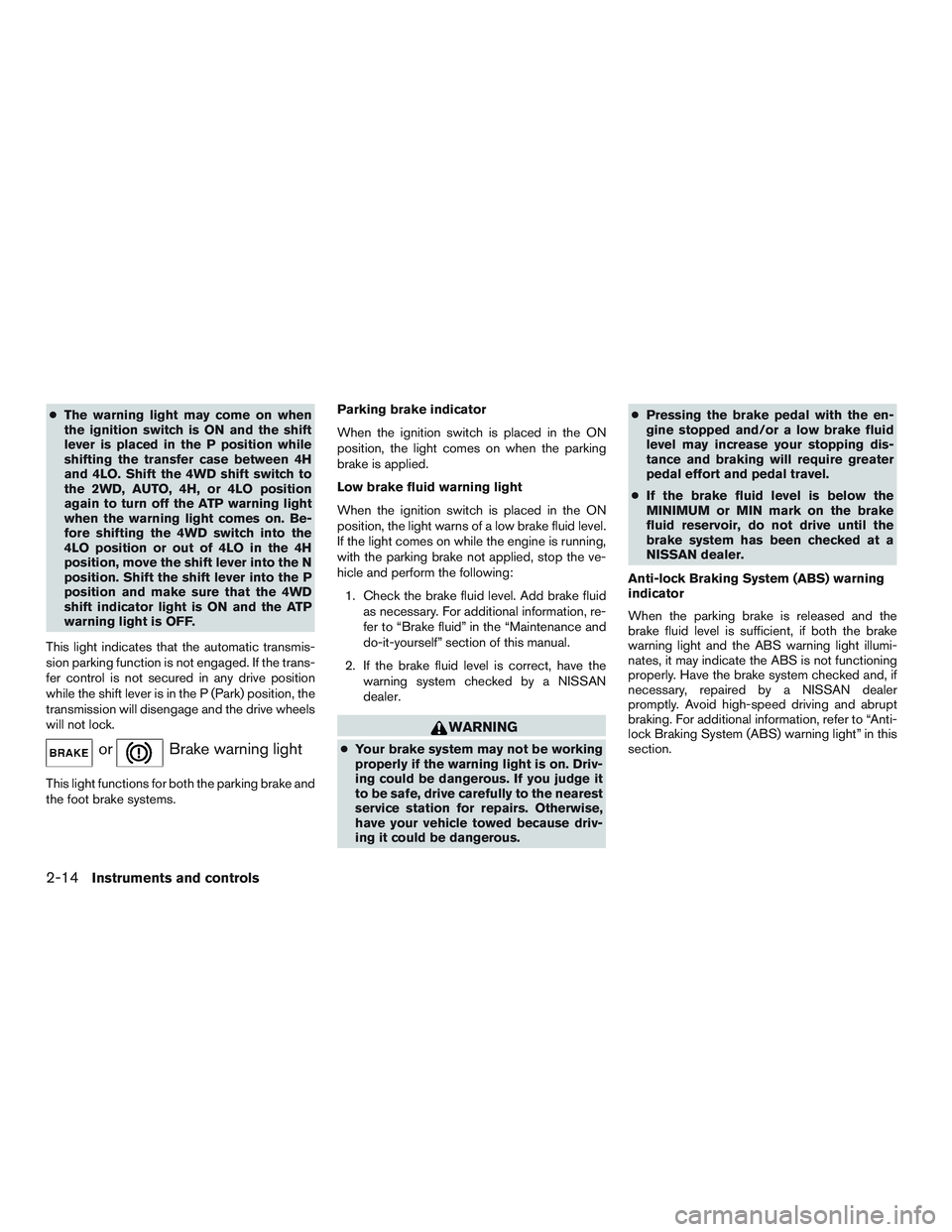
●The warning light may come on when
the ignition switch is ON and the shift
lever is placed in the P position while
shifting the transfer case between 4H
and 4LO. Shift the 4WD shift switch to
the 2WD, AUTO, 4H, or 4LO position
again to turn off the ATP warning light
when the warning light comes on. Be-
fore shifting the 4WD switch into the
4LO position or out of 4LO in the 4H
position, move the shift lever into the N
position. Shift the shift lever into the P
position and make sure that the 4WD
shift indicator light is ON and the ATP
warning light is OFF.
This light indicates that the automatic transmis-
sion parking function is not engaged. If the trans-
fer control is not secured in any drive position
while the shift lever is in the P (Park) position, the
transmission will disengage and the drive wheels
will not lock.
Page 361 of 510
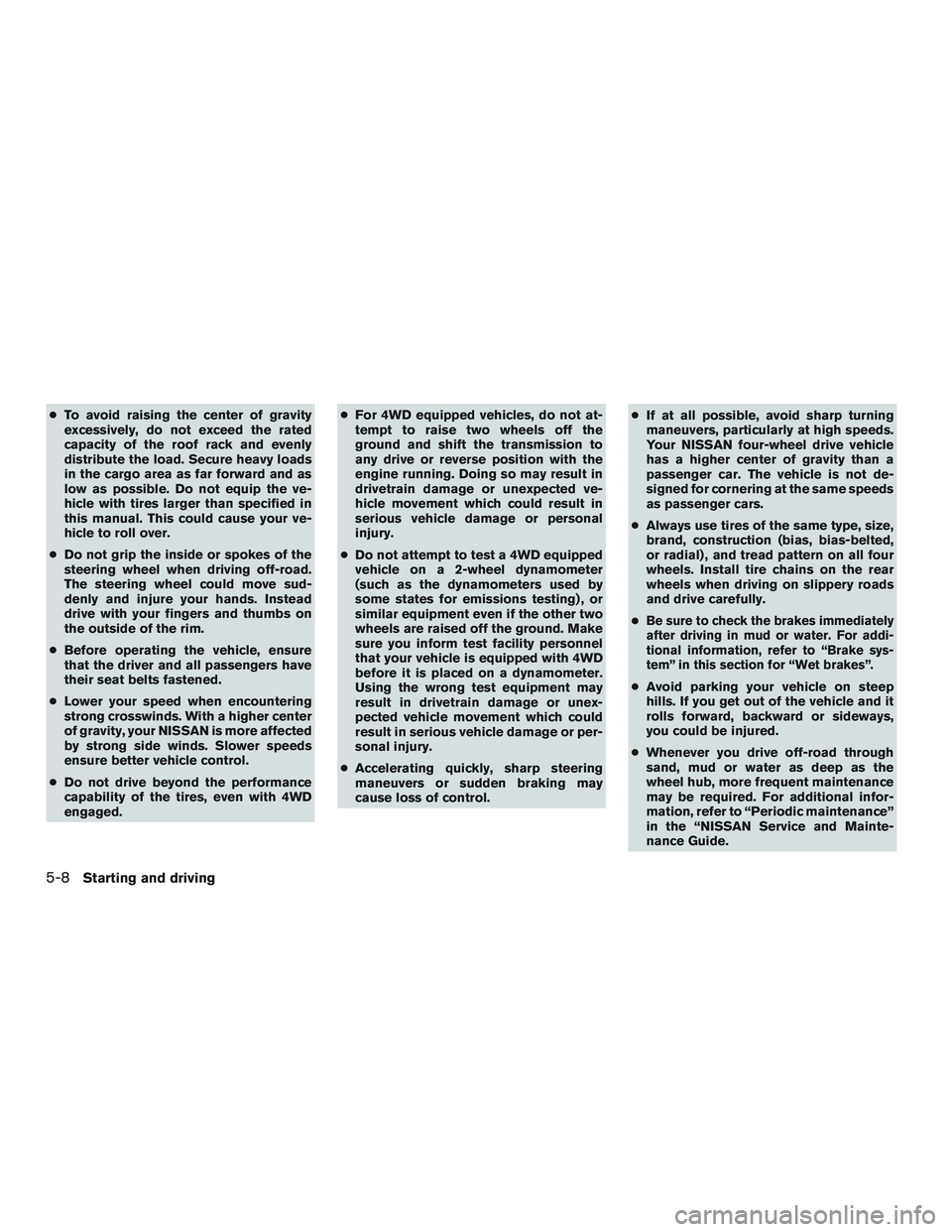
●To avoid raising the center of gravity
excessively, do not exceed the rated
capacity of the roof rack and evenly
distribute the load. Secure heavy loads
in the cargo area as far forward and as
low as possible. Do not equip the ve-
hicle with tires larger than specified in
this manual. This could cause your ve-
hicle to roll over.
● Do not grip the inside or spokes of the
steering wheel when driving off-road.
The steering wheel could move sud-
denly and injure your hands. Instead
drive with your fingers and thumbs on
the outside of the rim.
● Before operating the vehicle, ensure
that the driver and all passengers have
their seat belts fastened.
● Lower your speed when encountering
strong crosswinds. With a higher center
of gravity, your NISSAN is more affected
by strong side winds. Slower speeds
ensure better vehicle control.
● Do not drive beyond the performance
capability of the tires, even with 4WD
engaged. ●
For 4WD equipped vehicles, do not at-
tempt to raise two wheels off the
ground and shift the transmission to
any drive or reverse position with the
engine running. Doing so may result in
drivetrain damage or unexpected ve-
hicle movement which could result in
serious vehicle damage or personal
injury.
● Do not attempt to test a 4WD equipped
vehicle on a 2-wheel dynamometer
(such as the dynamometers used by
some states for emissions testing) , or
similar equipment even if the other two
wheels are raised off the ground. Make
sure you inform test facility personnel
that your vehicle is equipped with 4WD
before it is placed on a dynamometer.
Using the wrong test equipment may
result in drivetrain damage or unex-
pected vehicle movement which could
result in serious vehicle damage or per-
sonal injury.
● Accelerating quickly, sharp steering
maneuvers or sudden braking may
cause loss of control. ●
If at all possible, avoid sharp turning
maneuvers, particularly at high speeds.
Your NISSAN four-wheel drive vehicle
has a higher center of gravity than a
passenger car. The vehicle is not de-
signed for cornering at the same speeds
as passenger cars.
● Always use tires of the same type, size,
brand, construction (bias, bias-belted,
or radial) , and tread pattern on all four
wheels. Install tire chains on the rear
wheels when driving on slippery roads
and drive carefully.
●
Be sure to check the brakes immediately
after driving in mud or water. For addi-
tional information, refer to “Brake sys-
tem” in this section for “Wet brakes”.
● Avoid parking your vehicle on steep
hills. If you get out of the vehicle and it
rolls forward, backward or sideways,
you could be injured.
● Whenever you drive off-road through
sand, mud or water as deep as the
wheel hub, more frequent maintenance
may be required. For additional infor-
mation, refer to “Periodic maintenance”
in the “NISSAN Service and Mainte-
nance Guide.
5-8Starting and driving
Page 379 of 510
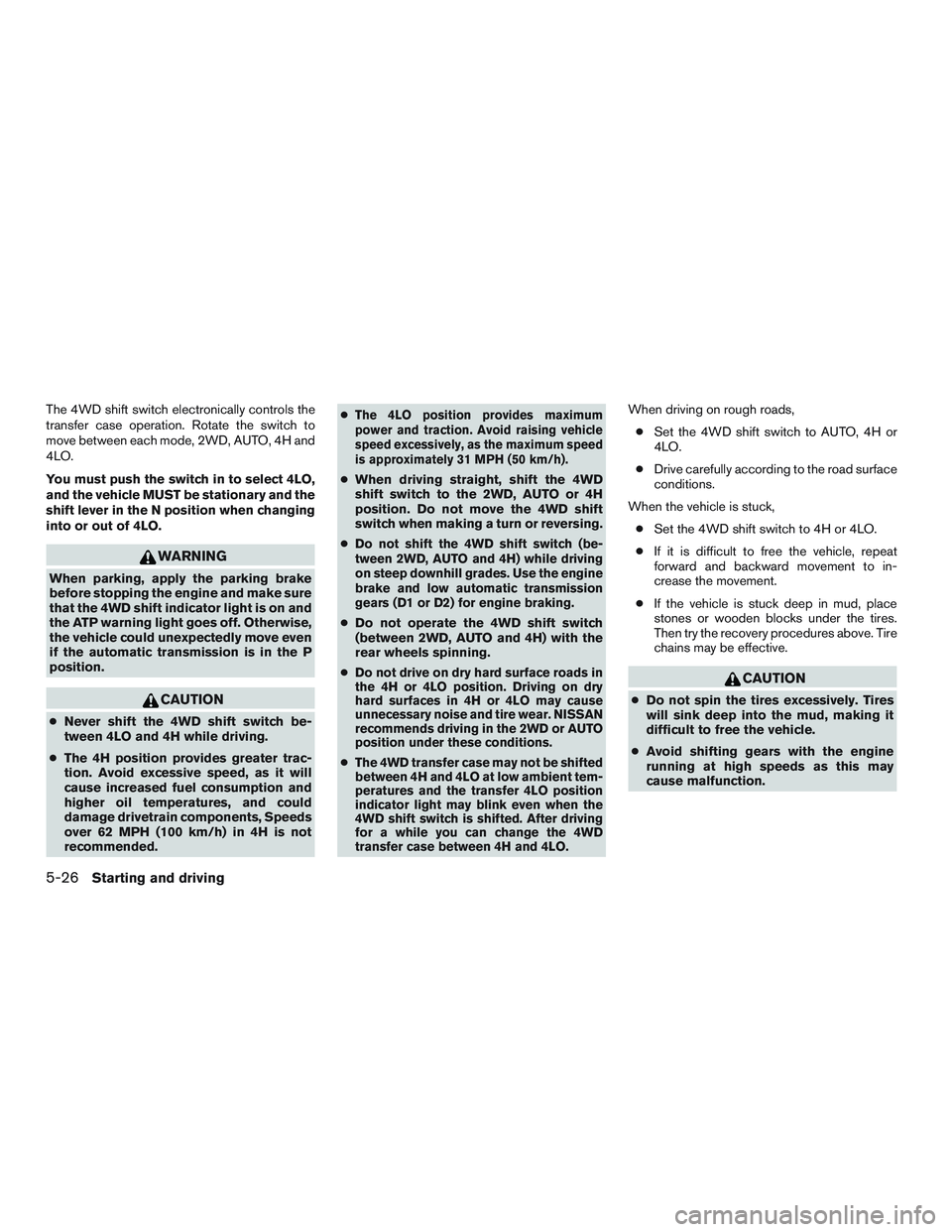
The 4WD shift switch electronically controls the
transfer case operation. Rotate the switch to
move between each mode, 2WD, AUTO, 4H and
4LO.
You must push the switch in to select 4LO,
and the vehicle MUST be stationary and the
shift lever in the N position when changing
into or out of 4LO.
Page 380 of 510
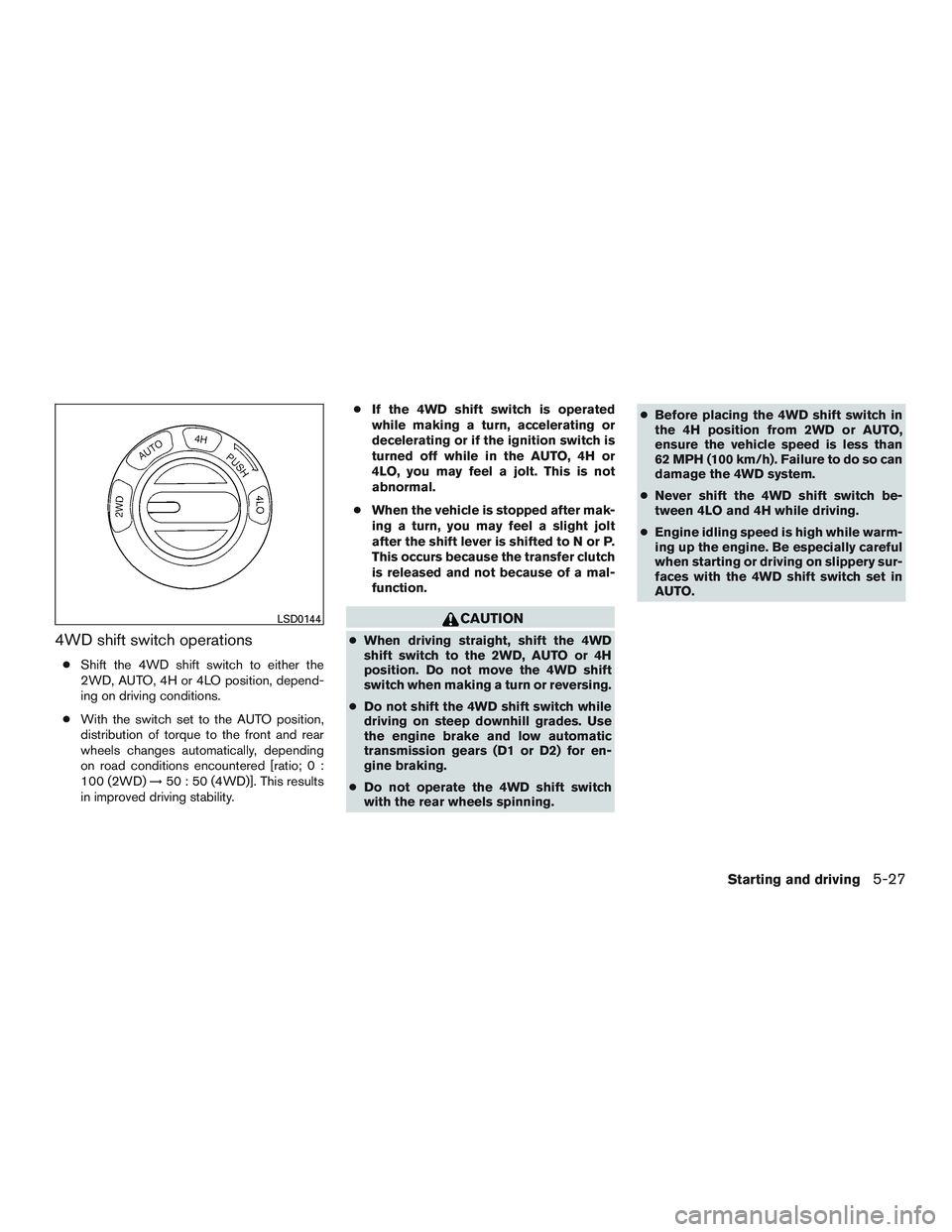
4WD shift switch operations
●Shift the 4WD shift switch to either the
2WD, AUTO, 4H or 4LO position, depend-
ing on driving conditions.
● With the switch set to the AUTO position,
distribution of torque to the front and rear
wheels changes automatically, depending
on road conditions encountered [ratio; 0 :
100 (2WD) →50 : 50 (4WD)]. This results
in improved driving stability. ●
If the 4WD shift switch is operated
while making a turn, accelerating or
decelerating or if the ignition switch is
turned off while in the AUTO, 4H or
4LO, you may feel a jolt. This is not
abnormal.
● When the vehicle is stopped after mak-
ing a turn, you may feel a slight jolt
after the shift lever is shifted to N or P.
This occurs because the transfer clutch
is released and not because of a mal-
function.
Page 381 of 510
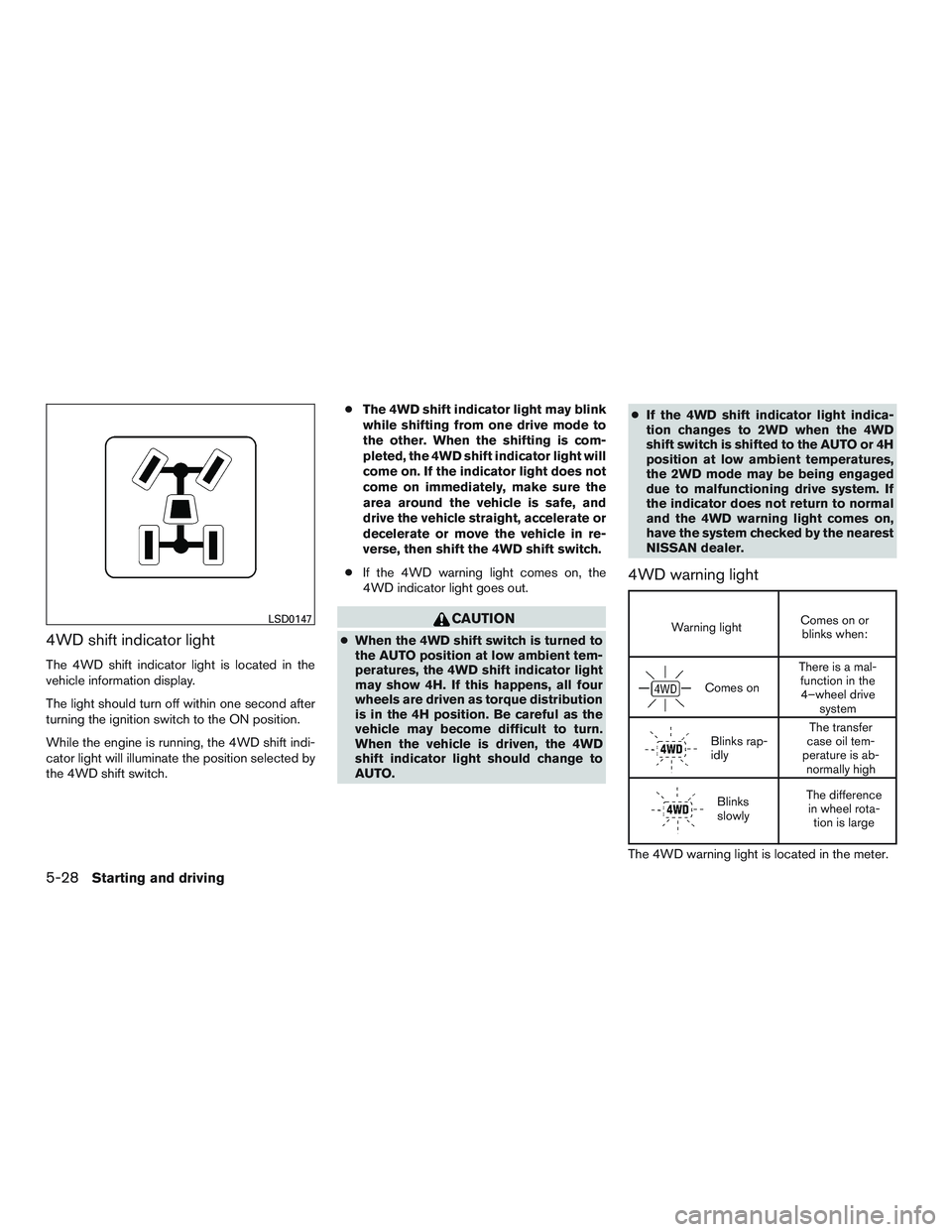
4WD shift indicator light
The 4WD shift indicator light is located in the
vehicle information display.
The light should turn off within one second after
turning the ignition switch to the ON position.
While the engine is running, the 4WD shift indi-
cator light will illuminate the position selected by
the 4WD shift switch.●
The 4WD shift indicator light may blink
while shifting from one drive mode to
the other. When the shifting is com-
pleted, the 4WD shift indicator light will
come on. If the indicator light does not
come on immediately, make sure the
area around the vehicle is safe, and
drive the vehicle straight, accelerate or
decelerate or move the vehicle in re-
verse, then shift the 4WD shift switch.
● If the 4WD warning light comes on, the
4WD indicator light goes out.
Page 382 of 510
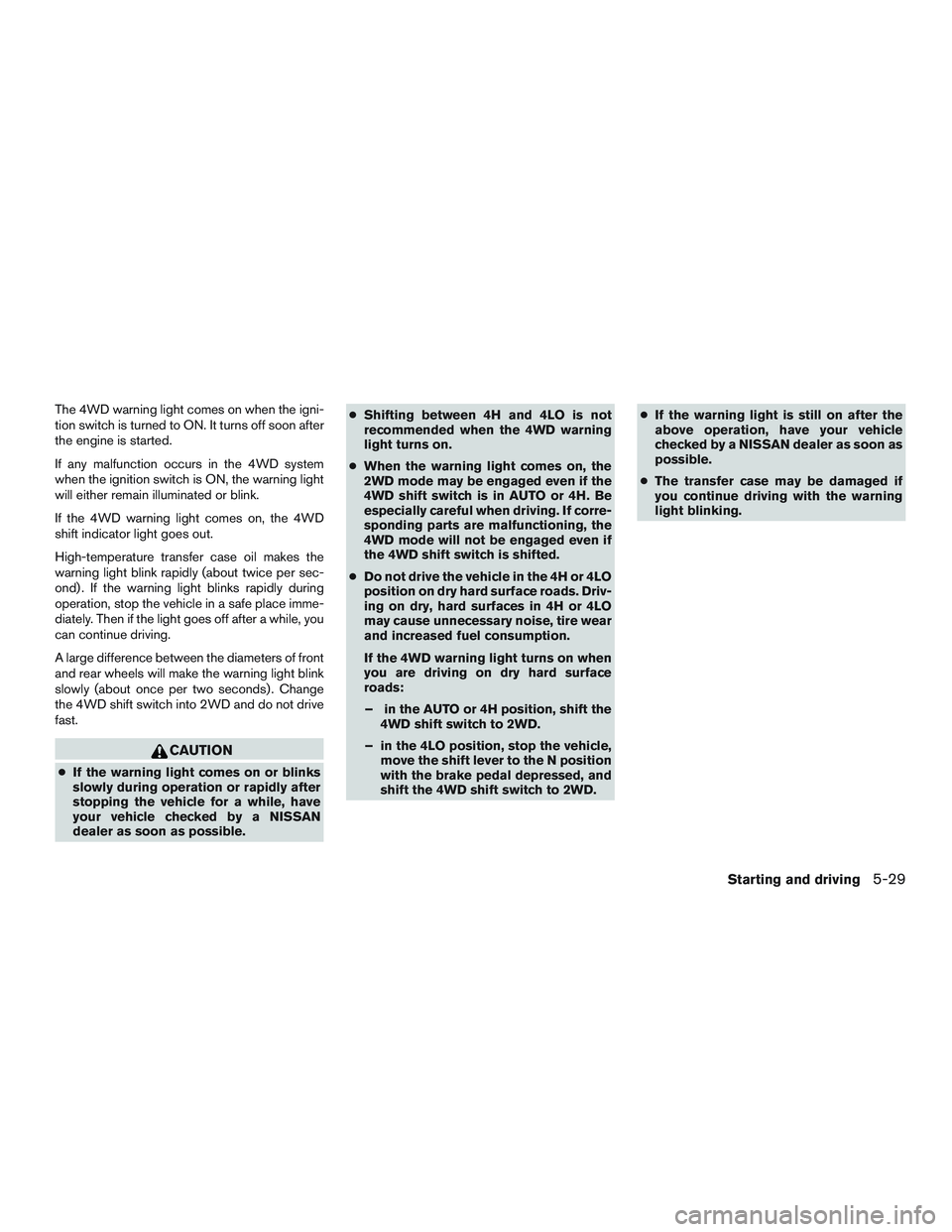
The 4WD warning light comes on when the igni-
tion switch is turned to ON. It turns off soon after
the engine is started.
If any malfunction occurs in the 4WD system
when the ignition switch is ON, the warning light
will either remain illuminated or blink.
If the 4WD warning light comes on, the 4WD
shift indicator light goes out.
High-temperature transfer case oil makes the
warning light blink rapidly (about twice per sec-
ond) . If the warning light blinks rapidly during
operation, stop the vehicle in a safe place imme-
diately. Then if the light goes off after a while, you
can continue driving.
A large difference between the diameters of front
and rear wheels will make the warning light blink
slowly (about once per two seconds) . Change
the 4WD shift switch into 2WD and do not drive
fast.
Page 506 of 510
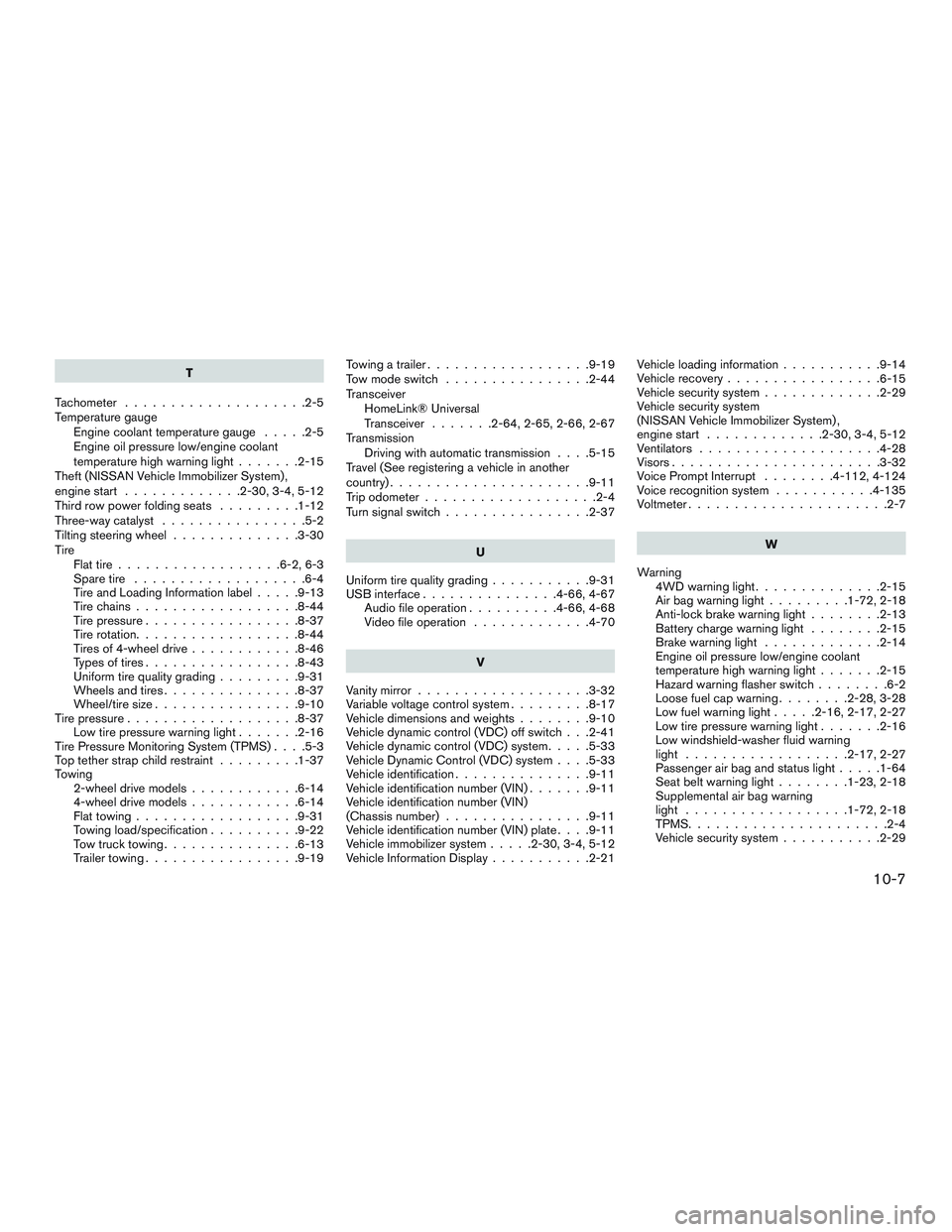
T
Tachometer ....................2-5
Temperature gauge Engine coolant temperature gauge .....2-5
Engine oil pressure low/engine coolant
temperature high warning light .......2-15
Theft (NISSAN Vehicle Immobilizer System) ,
engine start .............2-30,3-4,5-12
Third row power folding seats .........1-12
Three-way catalyst ................5-2
Tilting steering wheel ..............3-30
Tire Flat tire ..................6-2,6-3
Spare tire ...................6-4
TireandLoadingInformationlabel.....9-13
Tire chains ..................8-44
Tirepressure.................8-37
Tire rotation..................8-44
Tires of 4-wheel drive ............8-46
Types of tires .................8-43
Uniform tire quality grading .........9-31
Wheels and tires ...............8-37
Wheel/tire size ................9-10
Tirepressure...................8-37 Low tire pressure warning light .......2-16
Tire Pressure Monitoring System (TPMS) ....5-3
Top tether strap child restraint .........1-37
Towing 2-wheel drive models ............6-14
4-wheel drive models ............6-14
Flattowing..................9-31
Towing load/specification ..........9-22
Towtrucktowing...............6-13
Trailer towing .................9-19 Towing a trailer
..................9-19
Tow mode switch ................2-44
Transceiver HomeLink® Universal
Transceiver .......2-64,2-65,2-66,2-67
Transmission Driving with automatic transmission ....5-15
Travel (See registering a vehicle in another
country) ......................9-11
Trip odometer ...................2-4
Turn signal switch ................2-37
U
Uniform tire quality grading ...........9-31
USB interface ...............4-66,4-67
Audio file operation ..........4-66,4-68
Video file operation .............4-70
V
Vanity mirror ...................3-32
Variable voltage control system .........8-17
Vehicle dimensions and weights ........9-10
Vehicle dynamic control (VDC) off switch . . .2-41
Vehicle dynamic control (VDC) system .....5-33
Vehicle Dynamic Control (VDC) system ....5-33
Vehicle identification ...............9-11
Vehicle identification number (VIN) .......9-11
Vehicle identification number (VIN)
(Chassis number) ................9-11
Vehicle identification number (VIN) plate ....9-11
Vehicle immobilizer system .....2-30,3-4,5-12
Vehicle Information Display ...........2-21Vehicle loading information
...........9-14
Vehicle recovery ................. 6-15
Vehicle security system .............2-29
Vehicle security system
(NISSAN Vehicle Immobilizer System) ,
enginestart .............2-30,3-4,5-12
Ventilators ....................4-28
Visors.......................3-32
Voice Prompt Interrupt ........4-112, 4-124
Voice recognition system ...........4-135
Voltmeter......................2-7
W
Warning 4WD warning light ..............2-15
Airbagwarninglight.........1-72,2-18
Anti-lock brake warning light ........2-13
Battery charge warning light ........2-15
Brake warning light .............2-14
Engine oil pressure low/engine coolant
temperature high warning light .......2-15
Hazard warning flasher switch ........6-2
Loose fuel cap warning ........2-28,3-28
Low fuel warning light .....2-16,2-17,2-27
Low tire pressure warning light .......2-16
Low windshield-washer fluid warning
light ..................2-17,2-27
Passenger air bag and status light .....1-64
Seat belt warning light ........1-23,2-18
Supplemental air bag warning
light ..................1-72,2-18
TPMS ......................2-4
Vehicle security system ...........2-29
10-7